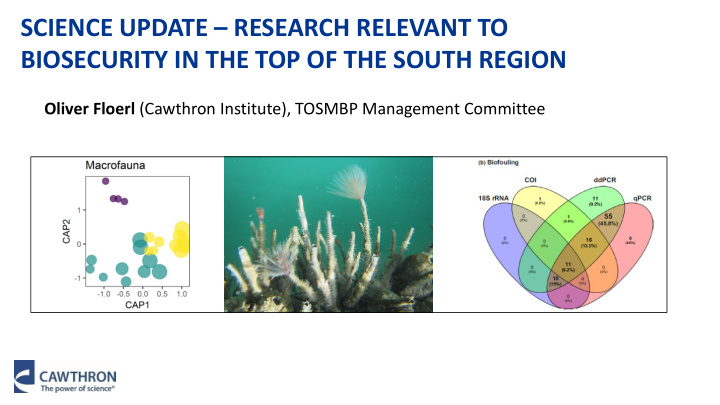



SCIENCE UPDATE – RESEARCH RELEVANT TO BIOSECURITY IN THE TOP OF THE SOUTH REGION Oliver Floerl (Cawthron Institute), TOSMBP Management Committee
SABELLA SPALLANZANII IMPACTS, BIOLOGY AND NOVEL DETECTION TOOLS 1. Experiments to determine ecological impact of fanworms in soft sediments Image: J. Atalah 2. Reproductive biology of Sabella 3. Optimisation of eDNA based surveillance tools
1. How does Sabella spallanzanii modify the functioning of soft sediment communities? • 2016 – 18, Rangitoto Channel • Transplants – worms and mimics • Density gradients (0-50 per m 2 ) • 6 months Examined impacts on: • Soft-sediment fauna (macro/micro) • Community respiration • Denitrification • Primary productivity
1. How does Sabella spallanzanii modify the functioning of soft sediment communities? • No impacts on sediment biodiversity • But shifts in the composition of sediment communities • Increased community metabolism and reduced denitrification • Worms change structure of above- sediment physical habitat Worm density
1. How does Sabella spallanzanii modify the functioning of soft sediment communities? Quantified impacts on ecosystem services Decision-making for investment in eradication / management Spatial spread Economic valuation of models ecosystem services Impact research leads Javier.Atalah@cawthron.org.nz Leigh.Tait@niwa.co.nz
2. PhD project: Sabella spallanzanii in the context of mussel farms in the Coromandel Project aims • Reproductive cycle and output • Seasonal presence of larvae around mussel farms Image: Kathy Walls • Larval development and settlement preferences • Potential for regeneration after fragmentation Sarah Brand Institute of Marine Science sbra338@aucklanduni.ac.nz
Reproductive cycle and output • 1,200 worms sampled over 1y • Worms <5cm (<10cm tube length) generally not reproductively mature • Sex ratio of 1:1 not confirmed • Wide range of egg sizes produced each month • Continuous egg production and gametogenesis, potentially enabling spawning events year-round • Evidence for a spawning event in Aug/Sept
3. Environmental DNA approaches to finding Sabella (and others) eDNA sample Anastasija.Zaiko@cawthron.org.nz
Marine biosecurity applications Biodiversity screening Target species detection Community-wide inventories Species-specific assays HTS metabarcoding qPCR, ddPCR Multiple taxa, incidental detections One-to-few known target taxa Validation of positive detections is High specificity recommended RNA (Ribonucleic acid) DNA (Deoxyribonucleic acid)
Targeted detection surveys to: Verify the results of traditional surveillance over various spatial scales Assess large-scale pest occupancy (distribution) Optimise surveillance designs and management programmes Verify eradication success over a constrained area (in prog.) Image: J. Atalah Image: J. Atalah
Method development/optimisation Sampling methods/matrices: filtered water International validation and standardization samples vs settlement plates vs sediment of pipelines eDNA and eRNA fate in water: Experimental Analytical platforms: qPCR vs ddPCR vs study of shedding and decay rates metabarcoding
Coupling eDNA signals with probabilistic models to: Estimate occupancy of the species (accounting for potentially imperfect detection) Estimate probability of detection for particular method/ sampling approach Design fit-for-purpose surveys - optimised detection probabilities for a given sampling effort Informed interpretation of non-detections In development: coupling eDNA with hydrodynamic models and novel sampling methods
FOR MORE INFORMATION…. J. Atalah (Cawthron) Javier.Atalah@cawthron.org.nz Ecological impacts L. Tait (NIWA) Leigh.Tait@niwa.co.nz Reproduction & S. Brand (Univ. of Auckland) sbra338@aucklanduni.ac.nz biology Molecular search Zaiko (Cawthron) Anastasija.Zaiko@cawthron.org.nz tools Other O. Floerl (Cawthron) Oliver.Floerl@cawthron.org.nz
Recommend
More recommend